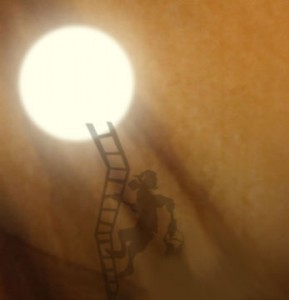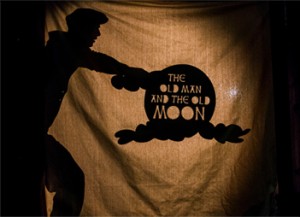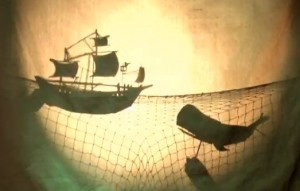 Writers Theatre was founded on a deep passion for the written word on the page, but dramatic storytelling was thriving long before pen first met paper. Homer’s Iliad, widely considered the oldest surviving work of Western literature, is merely the first written record of an oral storytelling tradition that dates back far earlier in the history of human civilization. The Old Man and The Old Moon, while utilizing a written script, is purposefully intended to evoke that oral storytelling tradition, bringing the audience back to a time when myths and folklore were paramount.
Writers Theatre was founded on a deep passion for the written word on the page, but dramatic storytelling was thriving long before pen first met paper. Homer’s Iliad, widely considered the oldest surviving work of Western literature, is merely the first written record of an oral storytelling tradition that dates back far earlier in the history of human civilization. The Old Man and The Old Moon, while utilizing a written script, is purposefully intended to evoke that oral storytelling tradition, bringing the audience back to a time when myths and folklore were paramount.
Of all the many images, characters and settings in the The Old Man and The Old Moon, the most obvious is, of course, the moon. Earth’s closest celestial neighbor has long been a primary motif in storytelling. “The Descent of Inanna,” a Sumerian poem that is one of the earliest recorded myths about the moon, dates back to circa 1750 BC.
Ancient civilizations often associated the moon with a female deity—generally a sister or relation to the sun god. In Ancient Greece, the moon goddess, Selene, was described as the more passionate sibling, with many stories of her romantic affairs, while her brother, Helios, was seen as more upstanding. The behavior of deities such as Selene contributed to the moon’s long association with irrationality and insanity (evidenced by the words lunacy and lunatic, derived from the Roman goddess of the moon, Luna).
 The concept of the moon having a leak and thereby needing to be constantly refilled is an original one, created by PigPen Theatre Co. for this particular play. However, there are many tales that try to explain the physical characteristics and imperfections of the moon’s surface. A Cherokee legend claims that the Sun, while being courted by someone whose face she could not see, rubbed ashes on the suitor’s face, and then when the moon rose the next night with spots she knew who had been trying to seduce her. Another American folktale speaks of three frogs who jumped across the moon’s face after he had invited them into his home. Both of these tales propose that the craters on the moon’s surface make it look like the face of a man, while other stories speak of a man who lives in the moon.
The concept of the moon having a leak and thereby needing to be constantly refilled is an original one, created by PigPen Theatre Co. for this particular play. However, there are many tales that try to explain the physical characteristics and imperfections of the moon’s surface. A Cherokee legend claims that the Sun, while being courted by someone whose face she could not see, rubbed ashes on the suitor’s face, and then when the moon rose the next night with spots she knew who had been trying to seduce her. Another American folktale speaks of three frogs who jumped across the moon’s face after he had invited them into his home. Both of these tales propose that the craters on the moon’s surface make it look like the face of a man, while other stories speak of a man who lives in the moon.
Another common mythological motif contained within The Old Man and The Old Moon is that of a lost city that cannot be found. Atlantis is one of the oldest examples of this type of myth, first written about by Plato in 360 BC. The island was claimed to have been a great power, conquering much of Western Europe and Africa, before sinking into the ocean “in a single day and night of misfortune.” Another example is El Dorado, the city of gold in the New World that the Spanish Conquistadors and other European explorers set out to find.
 At another point in The Old Man and The Old Moon, a character ends up in the belly of a giant fish. The narrative conceit of a fish or whale swallowing a person dates back to the biblical story of the prophet Jonah, who was trapped inside a whale for three days after refusing to follow God’s instructions. Another popular depiction of this story is in Carlo Collodi’s The Adventures of Pinocchio and its 1940 Disney film adaptation.
At another point in The Old Man and The Old Moon, a character ends up in the belly of a giant fish. The narrative conceit of a fish or whale swallowing a person dates back to the biblical story of the prophet Jonah, who was trapped inside a whale for three days after refusing to follow God’s instructions. Another popular depiction of this story is in Carlo Collodi’s The Adventures of Pinocchio and its 1940 Disney film adaptation.
The Old Man and The Old Moon is not, however, a pastiche of the highlights of classical mythology. The story draws upon familiar circumstances and imagery, but assembles each episode into its own sweeping narrative, (just as writers and adaptors have been re-purposing stories for ages), all woven around an original mythological conceit—that of the leaking moon. The result is a script that feels both charmingly familiar despite being wholly original, and it provides a firm literary anchor for these remarkable theatre artists to create the music, puppetry and characters that bring the production to stunning life.


No comments yet.